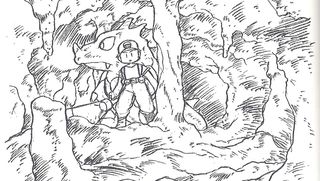Pockets and monsters - The history of Pokemon games
Catch up on more than 15 years of collectable monsters
Gotta catch 'em all!

Its been more than 15 years since Pokmon took Japans islands by storm, and since then the numerous species of portable critters have become beloved across the globe. The RPG is a monster of its own, laden with copious product tie-ins and spin-offs. Pokmon Black/White 2 marks the franchises first direct sequel, making this a perfect time to look at its history great and small. Well take a look at each generation, the various spinoffs, and some forgotten relics of Pokmons gaming history, seeing whats significant, what may actually be worth another look, and whats probably best left to rot in a box on Someones PC.
In the entries, we used Japanese, American, and Eurpopean release years when marking the dates.
1990 - Capsule Monsters

Pokmons beginnings go back much, much further than you might think. Satoshi Tajiri and Ken Sugimori founded Game Freak in 1989, after their passion for publishing homebrew game strategy guides blossomed into full-on game creation. After analyzing what the Game Boy hardware was capable of, the fledgling firm created a design document in 1990 for a game titled Capsule Monsters, based upon the idea of collecting, training, trading, and battling monsters in duels using the Game Boys system link cable.
The team hoped to finish the game for release by the next year, however, the project required more funding than Game Freak had on hand. Development on Capsule Monsters would start and stop over the years the company worked on various outsourced projects to earn extra cash and attempted to get publishers to fully commit to the idea. At one point in 1993, the company considered abandoning development on Capsule Monsters entirely, but when it came to a vote, the overwhelming majority of staff was in favor of finishing the game. Eventually, after years of work (and a solid track record of developing outsourced titles in their name), Nintendo committed to publishing and marketing Capsule Monsters though, due to trademark issues, the name would need to be changed to Pocket Monsters.
1996~1999 - Pokmon Red/Green/Blue/Yellow

Many a Poke-fan looks back fondly on the days of Red and Blue and the original 151, but what many people dont realize is that Red and Blue werent the original duo that debuted in Japan. In February of 1996, Pokmon was first unleashed in the form of Pokmon Red and Pokmon Green. Red and Green proved to be a massive sales success, but the games had a few lingering issues: they were incredibly buggy (yes, even more so than the international versions) and rough around the edges in a lot of places. To correct these issues, Game Freak developed and released Pokmon Blue later in the year. Blue featured notable improvements: the battle graphics were overhauled, numerous bugs were caught and corrected, previously unobtainable wild Pokmon could now be legitimately caught, certain areas were re-mapped, and the infamous Lavender Town music was made far less harsh-sounding.
The improvements made to the Japanese version of Pokmon Blue were retroactively applied to Red and Green for Pokmons eventual North American debut in 1998. The US Red and Blue versions kept the exclusive Pokmon of the Japanese Red and Green editions, respectively, making the Japanese version of Blue a fairly unique piece of Pokmon history. It also started a precedent which every Pokmon generation since has followed: An initial release of two versions, followed by a third some time later. Green was all but forgotten after the international debut, with Pokmon Yellow assuming its place as the third game in that particular Pokmon generation. Clearly, however, the Red and Green versions remain a strong memory in the hearts of Japanese players and the creators the later Pokmon Generation I remakes for the GBA would be titled FireRed and LeafGreen in all territories.
1998 - Pocket Pikachu

The virtual pet craze sparked by Tamagotchi had already begun to taper off by 1998, but that didnt stop Nintendo from releasing its own take on the concept. The Pocket Pikachu was a small, Game Boy-shaped device that could be clipped to or carried inside of ones pocket or purse. The units small screen would display a Pikachu you interacted with by playing games and racking up watts, which were earned through a built-in pedometer. Depending on how well and how often you would play with Pikachu, he would treat you differently, ranging from being exceptionally friendly to being distant and reluctant to recognize you. If you checked in on Pikachu at certain times of day, you would see cute animations of his daily routine.
Sign up to the GamesRadar+ Newsletter
Weekly digests, tales from the communities you love, and more
The unit proved successful enough at the time to be reissued during the debut of Pokmon Gold and Silver. The Pocket Pikachu 2 GS featured a slightly altered form factor, a color display, and the addition of an infrared port. The unit was capable of communicating to Pokmon Gold, Silver, and Crystal via the Game Boy Colors infrared port, and transferring a sufficient number of earned Watts would result in getting various items in-game. Though the Pocket Pikachu lineage would end at the second model, the inspiration for the later Pokewalker and 3DS system is quite obvious.
1998~2007 - Pokmon Stadium series

Portable games are fine and all, but what kid wouldnt be elated to see their big, bad Pokmon duking it out in full 3D? That was the train of thought that led to the development of Pokmon Stadium for the N64. The game featured a unique transfer pak that allowed players to insert a Game Boy cartridge and utilize their personal Pokmon team in full-on, 3D-rendered duels. The Pokmon Stadium that saw release in North America is actually Japans Pokmon Stadium 2 the original Japanese Pokmon Stadium was a horribly unfinished mess, with less than a third of the original 151 Pokmon available for use in battle (the rest had character models, but lacked animations). The series has continued onto the GameCube and the Wii under different, fancier-sounding names (Pokmon Coliseum, Pokmon XD, Pokmon Battle Revolution) but with similar concepts to the original Stadium games.
1998 - Hey You, Pikachu!

What would it be like to train and directly command a Pokmon with your voice? Thats the concept behind the interesting--though quite dull--Hey You, Pikachu! The game came with a microphone attachment for the N64 controller, which you could use to issue simple directions to the wild Pikachu you were interacting with. You didnt battle Team Rocket or anything, though--most of your interactions were menial tasks like looking after Caterpie babies and going fishing.
Originally called Pikachu Genki Dechu (a pun that translates roughly into Pikachus doing well) in Japanese, the game would be released in the US a little under 2 years later, following a complete retooling of the voice recognition engine for American English speakers--making for the longest wait between Japanese and North American releases after the original Red and Blue. Hey You, Pikachu! never appeared in Europe, primarily due to the difficulty of further language-recognition retooling. Even the English-speaking UK was left out--the rumor is that the voice recognition was so finicky that it wouldnt function correctly with the wide variety of accents seen across the territory. (Dont worry, guys, you didnt miss much.) The experiment paid off in the end, though: Hey You, Pikachu! is said to have been a testing ground for many features that were eventually implemented into the phenomenally popular Nintendogs franchise.
1998~2001 - Pokmon Trading Card Game and Pokmon Trading Card Game 2: Team GR Appears!

The Pokmon card game spin-off has always enjoyed a great deal of popularity, and the tabletop version was eventually adapted into electronic form for the Game Boy Color. The goal, much like the mainline Pokmon titles, is to work your way up the ranks of the Pokmon League, defeating eight Club Masters before fighting four Grand Masters for control of the powerful Legendary Cards. This adaptation was successful enough to earn a sequel, though only in Japan.
Titled Pokmon Card GB2: GR-dan Sanjou!, the game was a direct follow-up to the original, though with numerous improvements. The selection of a male or female protagonist--now a Pokmon standard--was added, as was a useful feature that could analyze the effusiveness of the players deck. Rather than just trying to defeat the Grand Masters, you had to build decks to compete with and defeat the threat of Team Great Rocket (the GR of the title). Its unknown why Nintendo didnt opt to bring this one Stateside, given the continued popularity of the card game and the warm reception of the original adaptation, but our guess is that Nintendo simply decided to focus more on the upcoming domestic Game Boy Advance launch.
1999 - Pokmon Snap

Pokmon Snap was one of the first Pokmon spin-offs to be released outside of Japan, and it proved just how well the franchises name alone could potentially carry a game that might otherwise get the cold shoulder from consumers. The gameplay itself doesnt sound terribly exciting: you simply take an on-rails ride through predetermined paths while trying to time photo shots to get the best possible pictures of Pokmon doing, well, Pokmon-y activities. But actually playing Snap revealed a unique, strangely relaxing, and intriguing experience. Since Pokmon fever was burning high at the time of its release, Snap performed very well, and it is still quite fondly remembered by many players. Pokmon Snap is available on the Wiis Virtual Console, so interested fans would do well to check it out.
1999 Pokmon Picross

Out of all the Pokmon titles that have appeared over the years, Pokmon Picross is among the most mysterious, mainly because it never saw any sort of release. Based on the picross series of nonogram picture puzzles (most recently seen in Picross 3D), Pokmon Picross was set to release on the Game Boy and Game Boy Color, and featured picture puzzles of various Pokmon. The only information about the game comes from an announcement in a Japanese magazine--any trace of the title eventually vanished, though Pokmon-themed puzzles have shown up in a few other Picross titles.
Image via Bulbapedia
1999~2003 - Pokmon Pinball series

Before it was swallowed up by Nintendo, HAL published one of the first pinball games for the Game Boy, an odd little title called Revenge of the Gator featuring a reptile-themed table. Nintendo kept that experience in mind when assigning development duties for a Poke-themed pinball title (though another developer, Jupiter, would also help out). Pokmon Pinball released on the Game Boy Color in a fairly unique rumble cartridge, which required an extra AAA battery and would provide force feedback as the player bounced the Poke-ball all around the two selectable tables (Red and Blue). A later GBA sequel, Pokmon Pinball: Ruby & Sapphire, would be released in 2003, missing the rumble feature while including many more Pokmon.
Henry Gilbert is a former GamesRadar+ Editor, having spent seven years at the site helping to navigate our readers through the PS3 and Xbox 360 generation. Henry is now following another passion of his besides video games, working as the producer and podcast cohost of the popular Talking Simpsons and What a Cartoon podcasts.
Most Popular



